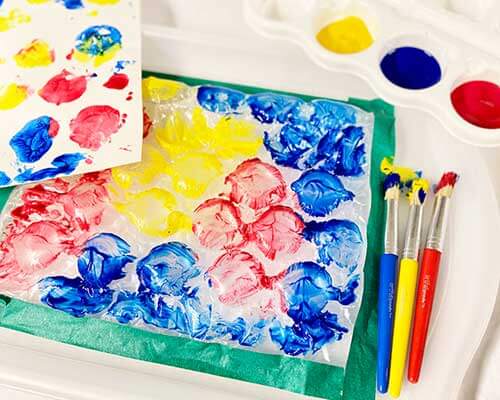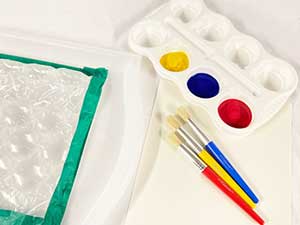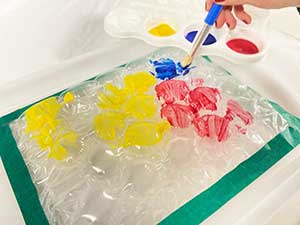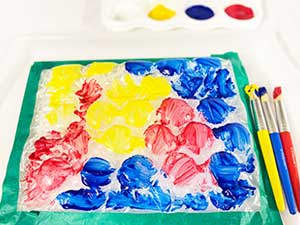Printmaking

Explore texture and color with printmaking!
Explore texture and color with printmaking!
Ages/Grades
Toddlers, Preschool, Early Elementary
Learning Domains
Language, Fine Motor, Science, Math
Materials
• Paint
• Construction paper - white or colorful (light colors work best)
• Cups or shallow dishes for paint
• Recyclable materials with interesting textures, such as egg cartons, bubble wrap, muffin tins, corrugated cardboard, and other packing materials from shipped boxes
• Paint and clay palm printers (optional)
• Textured stampers (optional)
Ready, Set, Create!
![]() Cover your work surface with a tablecloth or table paper, for easy cleanup.
Cover your work surface with a tablecloth or table paper, for easy cleanup.
![]() Lay textured recyclable materials on your work surface. You may wish to secure them with tape.
Lay textured recyclable materials on your work surface. You may wish to secure them with tape.

![]() Dip brushes into paint and then paint onto the textured surfaces.
Dip brushes into paint and then paint onto the textured surfaces.

![]() Gently press paper onto the painted textured materials. Rub and smooth the clean side of the paper with your hand, to make sure the paint transfers to the paper.
Gently press paper onto the painted textured materials. Rub and smooth the clean side of the paper with your hand, to make sure the paint transfers to the paper.
![]() Slowly pull the paper off of the painted surface to reveal your print.
Slowly pull the paper off of the painted surface to reveal your print.
![]() Repeat this process with different colors of paints and with different textured surfaces to create multiple layers of prints.
Repeat this process with different colors of paints and with different textured surfaces to create multiple layers of prints.

Engage Children in Conversation
Encourage children to paint designs or patterns of color on the textured materials, and then press paper on top to create prints. Try pressing the egg carton, muffin tin, or other materials onto the paper, instead of the paper to the carton or tin.
Ask children: What do your prints look like? What happens to your prints if you press the egg carton, muffin tin, or other materials onto the paper, instead of the paper to the carton or tin? Which process makes better prints? Why do you think that? How can you create other types of prints?
Extensions
Create a “texture wall” by gluing textured materials onto a large piece of cardboard and setting it out upright or against your easel area. When children paint while standing upright, they stabilize and strengthen shoulder, elbow/arm, and hand muscles. On a nice day, a texture wall can be taken outside and placed on the ground for painting and printmaking.
Try other ways of creating textured prints, such as using rubbing plates and crayons. Textured stampers or plates can be used to add another layer of paint to your designs.
Get outside and go on a “texture walk” around your neighborhood. Find objects with different textures, such as tree bark, sewer covers, and bricks. Bring crayons and paper and make rubbings of interesting textures you find.
Modifications
![]() Children can use paintbrushes and rollers of different sizes and with different handle thicknesses to make grasping easier. This activity is fun for children who prefer not to get messy, since they do not have to touch the paint while making prints.
Children can use paintbrushes and rollers of different sizes and with different handle thicknesses to make grasping easier. This activity is fun for children who prefer not to get messy, since they do not have to touch the paint while making prints.
